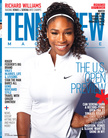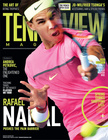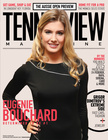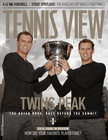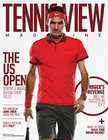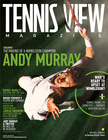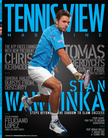Don't miss any stories → Follow Tennis View
FollowPart Two: The Truth About Tennis For The Recreational Player
Tennis View contributing writer, Greg Moran’s new book, “The Truth About Tennis: The Definitive Guide for the Recreational Player” is now available on Amazon.
Greg’s book was written specifically for the millions of recreational players around the globe. Described as the “Best coach of recreational players in the country”, Greg has been playing, teaching, studying, and writing about tennis for over 50 years. He’s spent more than 100,000 hours on the court helping thousands of players from ages 3 to 93 improve their tennis. Quite simply, he knows what works and, equally important, what doesn’t
Over the next (5) issues, we’ll be featuring excerpts from Greg’s bestselling book. As a bonus for Tennis View readers, Greg is offering complimentary copies of The Truth About Tennis to the first ten people that contact him (United States only). Greg can be reached a Gmfsrc@optimum. net.

Greg Moran
High-Percentage Singles
During the first two or three games, simply hit the ball down the middle of the court. This will keep your ball away from the sidelines and traveling over the lowest part of the net. It will also allow you to settle into a comfortable rhythm, shake off any nerves and find out a key piece of information: Can your opponent keep the ball in play?
At the 3.0 level and below, this is likely the only strategy you’ll need. Many players at these levels have a two to three shot attention span. After that, their mind wanders, and their patience evaporates. They go for a reckless, low percentage winner and hand you the point.
As you move to the 3.5 level and above, consistency alone will likely not be enough. Then, you should shift to playing high-percentage singles. Here are a few strategies to keep in mind.
Again, Forget the Big Serve
Many players today adopt the blast and push approach to serving. They fire away on their first serve, thinking that if it goes in, they’ll get an easy point as well as intimidate their opponent with their awesome power. They feel it’s a no-brainer approach because, if it doesn’t go in, they can always push in their second serve and still be in the point.
This may be effective at the 3.0 level and below where players don’t have the skills to take advantage of a weak second serve. However, at the 4.0 level and above, a strong opponent will eat your “push” serve for lunch.
Unless you can consistently hit your first serve in the court at more than 100 m. p. h. (you can’t and neither can I), going for the big serve is a waste of time and effort. Instead, view your serve as a tool to gain control of the point.
Strive to get 75% of your first serves in. Back off on the power and focus on spin and placement.
For placement, you have three primary targets: down the T, to the body and out wide. Of course, as the match progresses, you can adjust if you notice your opponent is significantly weaker returning on one side or the other.
Get Every Return of Serve Back in Play
Against a strong server on his first serve, think “react.” Use his pace and block the serve back. Aim your returns five to seven feet above the net and down the middle of the court. If he serves and volleys, aim one to two feet over the net and block your return down at his feet.
If the first serve is missed, shift into attack mode. Many teaching pros tell their students to move forward a few steps so that they can jump all over the weaker second serve. I strongly disagree.
When players think about jumping all over a second serve, more often than not they wind up getting too close to the ball and their stroke collapses.
Attack doesn’t mean you should try to end the point with one big shot. It means take control. Step into the ball, drive a deep crosscourt return and begin to dictate play.
Depending upon the quality of your opponent’s second serve, you may be able to move forward and attack the net. If so, think of your return as an approach shot. Hit it straight ahead and move into the net. Another option is to attack with touch and occasionally hit a drop shot off his soft, short second serve.
Aim Higher Over the Net to Hit Deep
In a singles rally, the quality of your shot is largely determined by its depth. Strive to keep the ball within three feet of your opponent’s baseline. To do this, aim five to ten feet over the net. Generally speaking, the lower your net clearance, the shorter your ball will land in the court. The pros masterfully use height to enhance both their groundstroke depth and consistency. Below are Rafael Nadal’s, Roger Federer’s and Djokovic’s average net clearance with their forehands during a recent season.
Nadal: 90 inches
Federer: 70 inches
Djokovic: 63 inches
The net height in the middle is 3 feet (36 inches). Roger Federer (at 70 inches) is hitting at a height of nearly two nets and Nadal (at 90 inches) comes close to three.
Hit Your Groundstrokes Crosscourt
Eighty to ninety percent of your groundstrokes should be hit crosscourt. The ball will travel over the lowest part of the net, and the court is longer on the crosscourt diagonal. This means that you can hit the ball harder and farther and still keep it in play.
Also, by hitting crosscourt, you’ll make your opponent run farther than if you hit down the line. The next time you practice, have one player hit all of his shots crosscourt while the other hits only down the line.
You’ll soon see that the player hitting down the line is doing much more running. Not only does this illustrate the point, it’s also a great consistency, speed, and conditioning drill.
As the point progresses, you’re waiting for your opponent to make one of three mistakes:
An impatient error that gives you the point.
A down-the-line shot that allows you to drive the ball crosscourt and run them off the court.
A short ball that allows you to move forward and attack.
In a baseline rally, position yourself diagonally across from where your opponent will be hitting their shot. From this position, you’ll be able to efficiently move to cover your opponent’s likely crosscourt return. The only exception occurs when you hit your shot right down the middle of the court.
Then, recover to the center of the court.
Hit Your Approach Shots Straight Ahead
There’s an old saying that “the point doesn’t begin until someone hits a short ball.” When that short ball comes, move forward and hit your approach shot straight ahead of where you strike the ball.
This will get the ball back to your opponent faster and also allow you to simply move forward to be in the proper position at the net.
Plus, by approaching straight ahead, you’ll always be in your opponent’s line of vision. As they move to hit their shot, seeing you directly in front of them will make them feel more pressured. On the other hand, if you hit crosscourt, he’ll be looking at a wide-open court in front of him, or he’ll be able to hit behind you as you sprint diagonally across the court to get to the net.
Take Control of the Net
Yes, even in this day of high-powered groundstrokes, the player who controls the net in singles controls the point. Look for every opportunity to move forward. However, keep in mind that, since you don’t have a partner to help you at the net, you need to be more selective as to when you move forward. Be sure that the shot you’ve hit, or the shot you’re about to hit, puts your opponent on the defensive before you move in.
Once you get to the net, remember that rarely will your first volley be the one that you can end the point with. Be prepared to hit at least two volleys. Play the first one back deep. After that, you can look for a volley to put away.
Pick one that is above the net and that you can move forward to hit.
When you control the net, the pressure is on your opponent so don’t force anything. If it takes two or three volleys and an overhead to win the point, so be it.
Be Patient
Be it a singles or doubles match with players of equal ability, it is the player (or team) who is more patient and willing to, as I like to say, suppress the stupidity that will usually come out on top.

